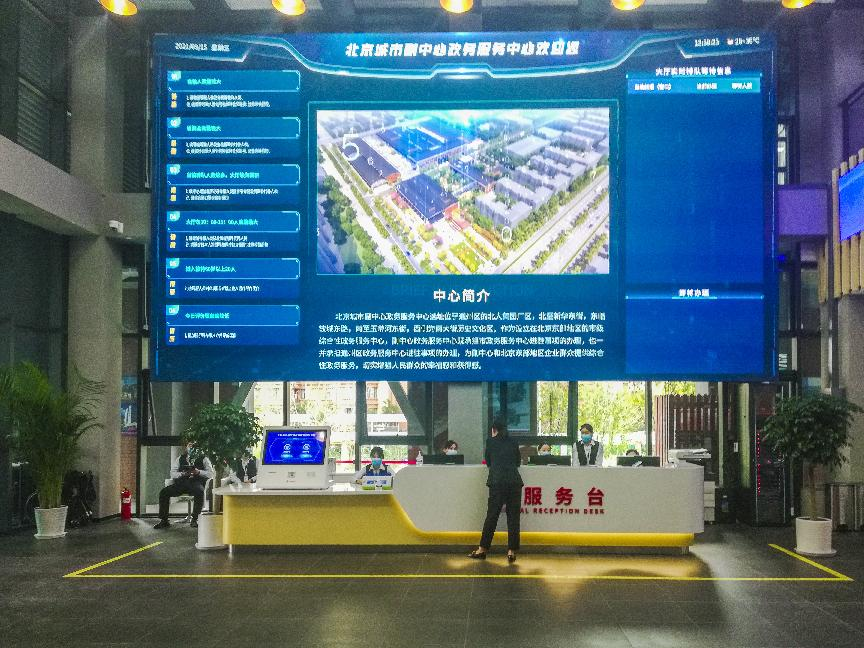Beijing's sub-center to embrace high-quality development

Photo shows the reception desk of the government service center of the Beijing Municipal Administrative Center, which was officially put into operation on Sept. 13, 2021. [Photo by Feng Jun/People's Daily Online]
The State Council of China recently issued a guideline on supporting the high-quality development of the Beijing Municipal Administrative Center (Beijing MC), or Beijing's sub-center, in Tongzhou district of Beijing, specifying development goals of the administrative center during the country's 14th Five-Year Plan period (2021-2025) and for the period before 2035.
The guideline put forward a package of targeted and workable policies and measures in a bid to support the high-quality development of the Beijing MC, said Cong Liang, deputy head of the National Development and Reform Commission of China, at a press conference held by the State Council Information Office on Dec. 1.
By 2025, Beijing's sub-center will basically have the functions of a green city, forest city, sponge city, smart city, cultural city and livable city, according the document.
By then, municipal-level Party organizations and government organs as well as administrative institutions in Beijing will be relocated to the sub-center. Meanwhile, the Beijing MC will see notable results in undertaking the non-capital functions of the city and housing new residents, and basically establish a quality system for development.
A modern sub-center of Beijing will be basically built by 2035, when its role in performing the non-capital functions of the city and helping with population transfer will be fully demonstrated, said the document.
Besides, the sub-center's quality system for development will become mature, and important results will be achieved in the integrated high-quality development of the sub-center and its surrounding areas, according to the guideline.
To drive the sub-center's high-quality development through innovation, the guideline proposed enhancing its scientific and technological innovation through measures including supporting the implementation of suitable policies of the new round of pilot reforms of core areas of the Zhongguancun National Independent Innovation Demonstration Zone at the sub-center.
It also called on encouraging law firms and accounting firms familiar with international laws and norms to set up offices in the sub-center to facilitate the innovative development of financial technologies in the Beijing MC.
The sub-center should be infused with greater development momentum and vitality and given more autonomy in development. According to the guideline, the sub-center should promote the rational conversion of the types of land uses in different industries and try to increase the supply of mixed-use land for industries.
It should pilot policies on high-level trade and investment facilitation and carry out pilot programs for international talent service and management reforms and international vocational qualification recognition in key areas.
The sub-center and Xiong'an New Area in north China's Hebei province serve as two new "wings" of Beijing and are assigned the important task of relieving the non-capital functions of the city.
In January 2019, the first batch of 165 units of 35 departments of Beijing municipal government moved their offices to the sub-center officially.
Based on the guideline, Beijing has listed 66 specific tasks to support the high-quality development of its sub-center, and made lists of projects and policies related to these tasks, noted Cui Shuqiang, a member of the Standing Committee of the Communist Party of China (CPC) Beijing Municipal Committee and executive vice mayor of the municipal government of Beijing, at the press conference.
Beijing plans to relocate the second batch of administrative institutions to the sub-center by 2022 or the year after that. It means approximately 30,000 more people will move to the sub-center, which is believed to ease the population pressure on the core areas of Beijing's central urban areas, Cui said.
With regard to cultural tourism, this year witnessed the opening of the Universal Beijing Resort, the 40-kilometers Beijing section of the Beijing-Hangzhou Grand Canal, and the 20-kilometer Hebei section of the Grand Canal opened to navigation, Cui noted.
Beijing is ramping up efforts to connect the two sections of the Grand Canal, according to Cui. It is estimated that Beijing residents will be able to take a boat along the canal to Hebei next July.
The guideline also pointed out that by 2025, an integrated high-quality development system concerning Tongzhou district as well as Hebei's Sanhe city, Dachang Hui autonomous county and Xianghe county will be basically established.
A planning system for the coordinated development of Sanhe city and the two counties in Hebei, the Beijing sub-center and Tongzhou district has basically taken shape, according to Hu Qisheng, vice governor of the provincial government of Hebei.
Up to now, 10 roads connecting Tongzhou and Hebei's Sanhe city, Dachang Hui autonomous county and Xianghe county have been completed and opened to traffic, and 21 bus routes have been opened along the roads, Hu said.
The official added that Sanhe city, Dachang Hui autonomous county and Xianghe county have witnessed continuous improvement in the quality of their ecological environment including the atmospheric environment and water bodies, with their overall average PM2.5 concentration dropping by 50 percent between 2016 and 2020.
Hebei will promote the improvement in the quality of the ecological environment of Sanhe city, Dachang Hui autonomous county and Xianghe county along with that of the ecology in Tongzhou, explore coordinated management and control of the early warning of and response to severely polluted weather in these regions, and join hands with the Beijing sub-center to build a large-scale green ecological space, make plans for the construction of Chaobai River national forest park, and carry out the protection and restoration of important river systems and ecological corridors including the North Canal River, so as to create sound ecological conditions for the construction of the Beijing MC, Hu said.
























